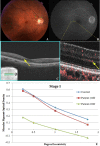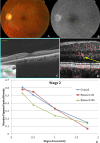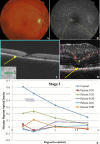Staging of macular telangiectasia: power-Doppler optical coherence tomography and macular pigment optical density
- PMID: 23716628
- PMCID: PMC3700387
- DOI: 10.1167/iovs.12-11116
Staging of macular telangiectasia: power-Doppler optical coherence tomography and macular pigment optical density
Abstract
Purpose: Two methods were used to study the stages of macular telangiectasia (MACTEL): Power-Doppler optical coherence tomography (PD-OCT), which allows imaging of the retinal circulation in three dimensions, and macular pigment optical density (MPOD), which quantifies the distribution of macular carotenoids.
Methods: Among 49 patients with MacTel identified, 12 eyes (6 patients) with MacTel and 7 age-matched control eyes (7 patients) were imaged with a custom-built Fourier-domain OCT instrument to acquire PD-OCT images. MPOD was measured using heterochromatic flicker photometry in 10 eyes (5 patients) with MacTel and compared with 44 age-matched control eyes (44 patients). Clinical staging of MacTel was based on best-corrected visual acuity, fundus biomicroscopy, fluorescein angiography, and OCT.
Results: Stage 1 eyes (n = 2) had subtle punctate vascular signal confined to the inner portion of the outer plexiform layer (OPL) on PD-OCT. Stage 2 (n = 2) showed larger oblique vascular signal extending into deeper OPL. Stage 3 (n = 5) had disruption of outer retinal layers with abnormal vasculature extending into the outer nuclear layer. Stage 4 (n = 3) showed diffuse blurring of the retinal layers with vascular channels extending the full thickness of the retina. MPOD values in four eyes with stage 1 or 2 MacTel correlated well with age-matched controls. Six eyes with stage 3 or 4 MacTel had loss of MPOD especially at the fovea.
Conclusions: PD-OCT shows penetration of the retinal capillaries into the deeper retinal layers in early stages of MacTel, with full thickness vascular proliferation in advanced disease. MPOD is commonly depleted but may appear normal in early stage MacTel.
Keywords: Power-Doppler; heterochromatic flicker photometry; idiopathic macular telangiectasia; macular pigment; optical coherence tomography; retinal telangiectasia.
Figures





References
-
- Charbel Issa P, Holz FG, Scholl HPN Findings in fluorescein angiography and optical coherence tomography after intravitreal bevacizumab in type 2 idiopathic macular telangiectasia. Ophthalmology. 2007; 114: 1736–1742 - PubMed
-
- Gass JD, Blodi BA. Idiopathic juxtafoveolar retinal telangiectasis. Update of classification and follow-up study. Ophthalmology. 1993; 100: 1536–1546 - PubMed
-
- Yannuzzi LA, Bardal AM, Freund KB, et al. Idiopathic macular telangiectasia. Arch Ophthalmol. 2006; 124; 450–460 - PubMed
-
- Gass JD, Oyakawa RT. Idiopathic juxtafoveolar retinal telangiectasis. Arch Ophthalmol. 1982; 100: 769–780 - PubMed
-
- Yannuzzi LA. The Retinal Atlas. Oxford, UK: Saunders Elsevier; 2010: 422–429
Publication types
MeSH terms
Substances
Grants and funding
LinkOut - more resources
Full Text Sources
Other Literature Sources

